
IYP 不是过眼云烟的新闻网站,我们提供实战能力,这里是值得您反复回看的档案室:iyouport.org
Year-End Ritual: Drawing the Future on a Blank Paper (Episode 4) - Yes, there is an uprising that is hard to suppress
What a stupid concept is "hostile foreign forces"? The uprising knows no borders. There is no "realm".


欢迎回来!这里是第4集。
If you missed it, you can see it below:
- " Year-End Rites: Drawing the Future on White Paper (Episode 1) - Are we "Iranian"? 》
- " Year-End Ceremony: Drawing the Future on White Paper (Episode 2) - The torch has been lit, what next? 》
- " Year-End Ceremony: Draw the Future on White Paper (Episode 3) - Compete for IQ with the rulers, not with the public "
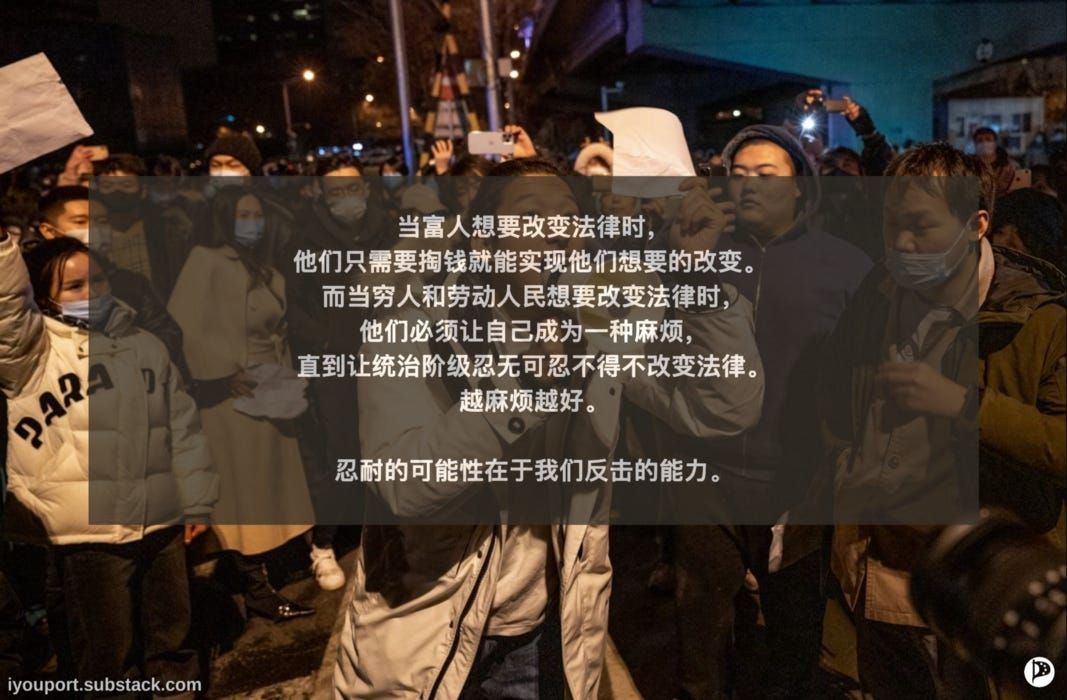
[Updated on the channel on October 15th ]
The following text is translated from Mobilization of the Russian Resistance. We think it should be helpful to dissidents in China —
How can one resist state violence? What many people think of are street protests — rallies.
"Still rallying!? Rallying won't solve anything. They just put everyone in police cars and the whole protest is over!"
If you think so, fine. In essence, rallies in contemporary Russia are “parades,” or simply walks. But you should not condemn people who use this lowest form of protest: we all live in an authoritarian state with a strong police system, and the rulers deny the possibility of all other forms of protest.
Our patience has been worn out for 10 years. Enough, enough!
Countless single rallies, countless exhausted activists, must coalesce and develop into a truly lasting uprising. Putin has driven us into a dead end and is threatening us and the world with nuclear weapons. Continuing to wait is fatal .
"But the rally has never succeeded! What reason is there to believe it will succeed now?"
The key to a successful protest is unity. Unity shows our strength. Only when people unite can we destroy this regime. When we no longer watch our fellow citizens being beaten and leaf through torture report after torture report with indifference, then no amount of repressive forces can stop a united people. Especially if instead of going out for a night, people get together and hang out for a few days .
"Let the elites handle this. We are tired of politics."
This can be answered with a quote from Carol Hanisch: “The personal is political.” Politics surrounds all of us, and if you want to live in your country, you have to take politics into your own hands.
There will be no palace coup. Putin has long since purged his entourage of the bravest and most righteous. The rest are scum like him. There are indeed many elites who are willing to change the status quo by "supporting the people", but they will never take the first step themselves. This is our mission.
The thought of rallies, of uprisings, is a little scary. The stakes are really high. But announced conscription mobilizations and stacks of repressive laws have shown that we must now prepare for the moment when the regime is on the verge of collapse. Get ready to fight for our own freedoms and futures, and for each other. Together we will win.
🧬If you missed it;
" This time, it's do or die: the war in Ukraine" 7 》
" "Freedom for the People, Death to the Empire" — Analysis of the Situation by Russian Anarchists 5 》
" Joining the Resistance Movement Under Conditions of Extreme Repression "
#Russia #Resistance #Revolution
Q: There are probably too few people this time, but we don’t have that many people... What should we do if there are always too few capable and brave people? Is there any way to get more people to join the resistance? It is best to use a method that does not require persuading other people. The effect of persuasion is too poor... Many people were scared away when the crackdown started. It is very difficult to form an organization. Is there any organizational method that can resist the crackdown?
iyp : Yes. There is a form of organized uprising that is extremely difficult to suppress and does not require as many people.
This form of organization was initiated in the late 20th and early 21st centuries. The rapid development of communication technology gave individuals and small groups super power - the ability of individuals to use rapidly developing technological tools to complete tasks and to access global networks has skyrocketed. . This enables small groups to radically increase their effectiveness in conflict.
Social media communication and mobilization is not what many people understand. It's called the Open Source Uprising . This is something we didn't cover in detail in our action tutorial .
The open source uprising is a byproduct of technological leaps and globalization. It is a method of organizing a large number of small, highly capable groups that band together to defeat a larger opponent (usually one that would be considered extremely difficult by a conventional uprising).
I will try to explain it from all aspects and also compare it with China’s white paper operation.

Key features of the open source uprising include:
1. It does not have a formal structure.
An open source uprising differs from traditional guerrilla warfare in that it has no clear focus—that is, it has no unifying ideology , hierarchical leadership, or organizational structure that were once typical of 20th-century practices and are now becoming obsolete.
During the white paper protests, we also saw some comments struggling with ideological positioning and arguing for a centralized or decentralized operating model. In fact, these are not important. The only thing to be wary of is any resistance to revolution (as the corporate media did with the Iranian uprising ; and any disruption and manipulation created through disputes ).
For an open source uprising, all it takes is one promise to “ignite” the participants…
2. A credible commitment.
A shared vision for a goal that seems realistically achievable, brought together in a project.
For example, a life without hegemony and survival in a system controlled by hegemony. And any proof and demonstration that “the ruling class is not indestructible” and “we can do it.”
3. A wide range of participants.
Literally, "open source" means that anyone can join. In an open source uprising, the participating guerrillas do not belong to a single group but to dozens of different groups, each with their own motivations for participating.
An open source movement can emerge on a scale far greater than that of a single rally, ideology, or political party. Macro-level processes that support uprisings can only emerge at the interface of different ideological groups.
People join it because they are influenced by something.
4. Mobilization is achieved through the power of demonstration, not ideology.
It is political logic, not political statements, that is copied and disseminated. This is why (structural) anarchism can suddenly become a haven for hundreds of thousands of people – across the entire ideological spectrum; who do not express anarchist ideas but embody these ideas by following illustrative demonstrations.
This applies to both violent and non-violent actions .
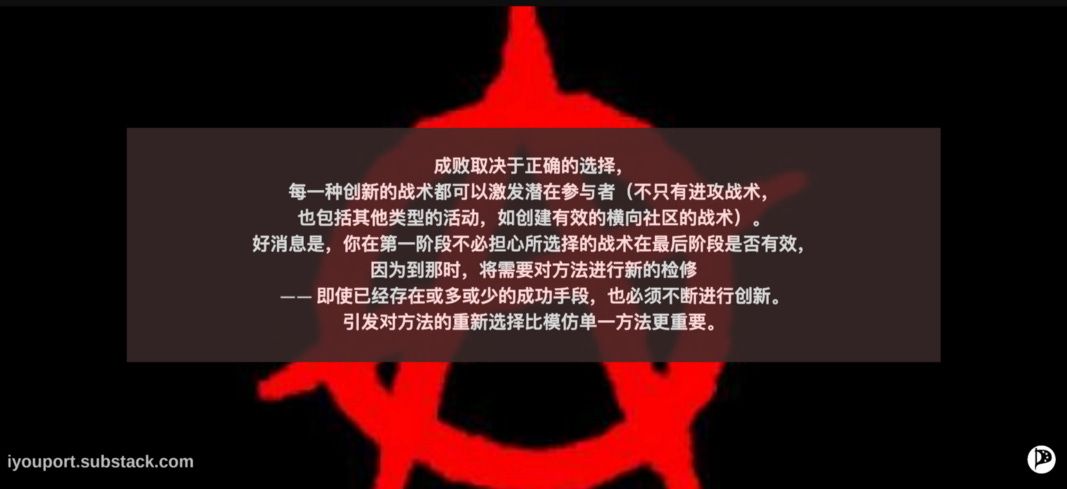
Open source uprisings are often inspired by a small group of promoters, a Foquismo in guerrilla parlance. Foquismo establishes a “credible commitment” to other participants in the open source uprising: setting an attractive goal and carrying out actions to show that the goal can be achieved.
Credible commitments include:
1. A clear image of the enemy - the enemy as the target of attack. The enemy can be any group that holds and exercises power: occupiers, governments, corporations, nationalist groups or organized crime groups.
2. Simple Purpose – Goals inspire organizations. The most defining feature of an open source uprising is the diversity of groups and individuals involved, so only simple and basic goals can make a difference.
Overly detailed goals will only narrow the pool of intended participants in the open source uprising and trigger forks/splits of the project.
The goal should be broad enough that everyone can interpret it according to their own needs.
Reasons for dissatisfaction and rebellion never disappear—but they can shift quickly.
A good common purpose enables participants to embody themselves, thrive, and continue to emerge even when suppressed.
3. Demonstration – Demonstration is the most important part here so that others can believe in the feasibility of this format.
Demonstrations are used to show that defeating an opponent is possible—they undermine any aura of invincibility the opponent may have and inspire other participants' desire to imitate.
The optimal size for Foquismo is five people (the so-called “rule of five”). More specifically, a group can include any number of loose members, but should have about five active members at its core with strong cross-connections to each other.
It should be noted that the smaller the number of participants, the project cannot be organized effectively, and the larger the number of participants, the more likely it will be a crisis due to overloaded channels (and people) - as the group develops, members will demand more guidance from the group. will also increase. At some point, it will start to consume too much energy. This can be avoided if you expand your network only at the expense of weak ties. Additionally, weak ties are also easier to remain anonymous/safe. Too many strong tie members increase group risk.
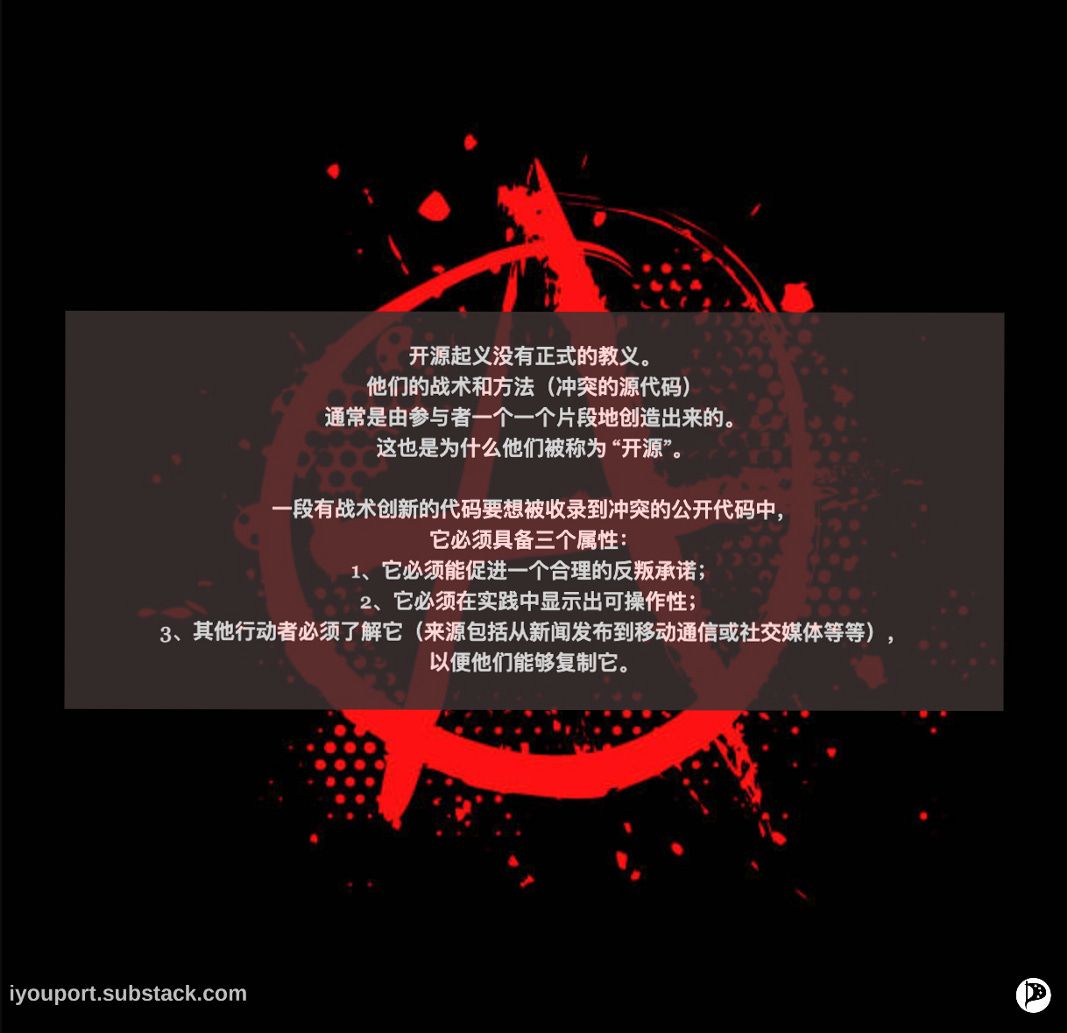
Not every group that wants to be in the “focus” will be in the “focus.” There must be an evolution of competition and methods in which most guerrilla groups "burn out" or remain average, while only a few groups are able to create the focal effect.
But on the other hand, joining an existing open source uprising is easy: follow a common goal and replicate a successful approach. Modify them appropriately to try to innovate.
The Open Source Revolt has no formal doctrine. Their tactics and methods (the source code of the conflict) are often created piece by piece by the participants. This is why they are called "open source".
In order for a piece of tactically innovative code to be included in the public code of the conflict, it must have three attributes:
1. It must promote a reasonable commitment to rebellion.
2. It must show operability in practice.
3. Other actors must know about it (sources range from press releases to mobile communications or social media, etc.) so that they can replicate it.
You can also share code. Anyone can do it. At any time. As long as the above three attributes can be met.
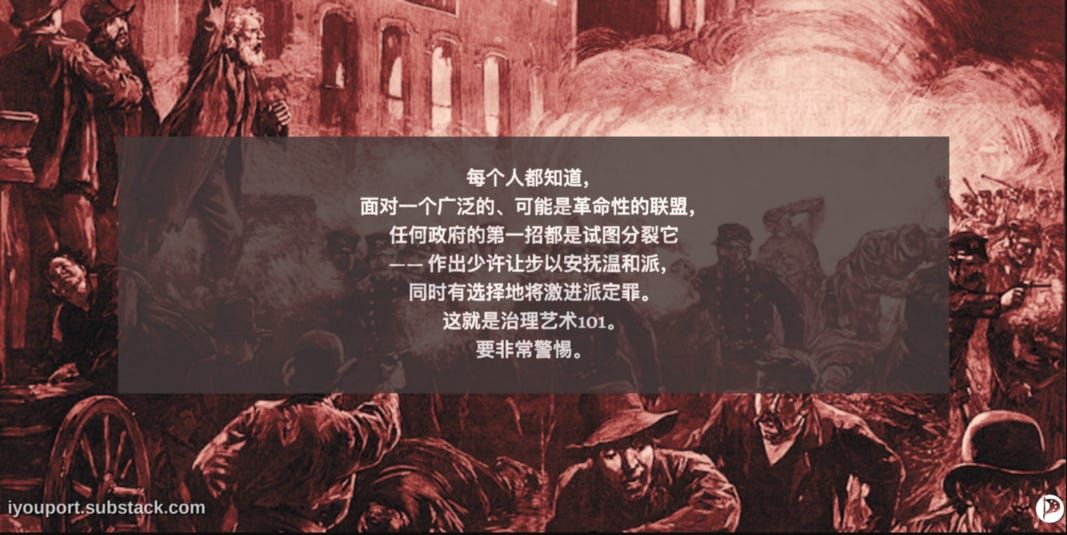
Advantages and disadvantages
Here are some characteristics of the open source uprising;
- high level of innovation
- Improves the survivability of participating groups
- More frequent attacks and group attack capabilities on targets
Once this organizational model achieves critical mass, its advantages are numerous; chief among them is that once an open source uprising reaches the point of self-replication, it is nearly impossible to eradicate. The bad news is that the open source uprising is hard to get off the ground — that is, overcoming the chasm of being open to collaboration from other groups and reaching critical mass is not easy.
But it seems some groups have managed to master an algorithm for making it easier to gain critical mass in an open source uprising. It adapts the concept of focus.
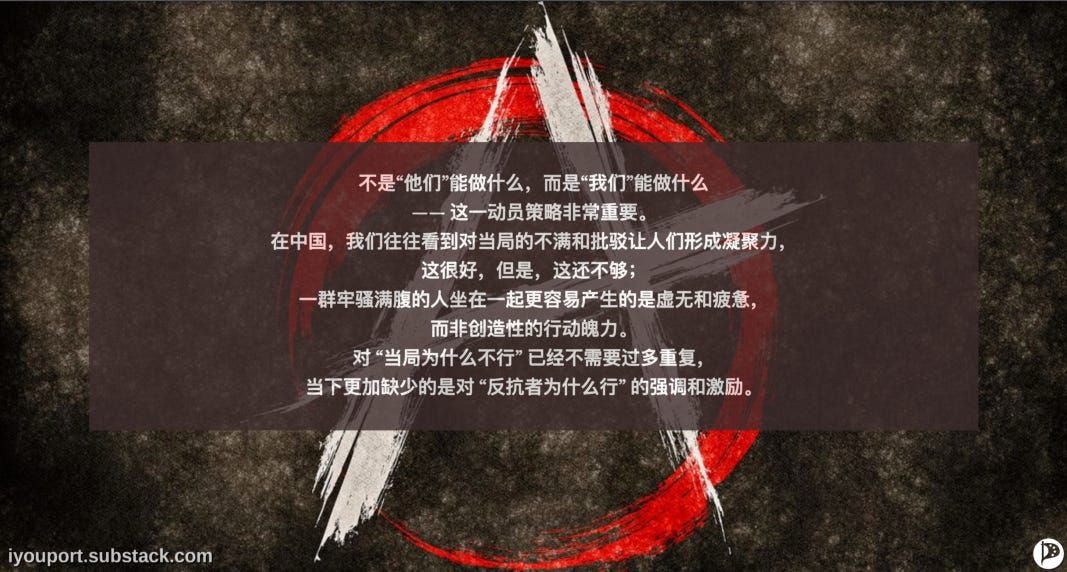
This is just one way to start the open source uprising—better technology will surely emerge over time.
According to this algorithm, here are the steps an open source uprising should go through:
1. Formulate a reasonable commitment.
The key is to find an idea (e.g. evict occupiers, or force the government to abandon intensive development of an area, or lift censorship blocks on the Internet, etc.). Once you identify the idea, you need to turn it into a reasonable commitment. This can be achieved by conducting a successful attack on a selected target - how to choose the appropriate target was covered in the previous episode. If done correctly, your actions will prove the target is vulnerable and win the battle. That is, establish a "focus."
2. Cross the chasm.
The key to moving from a "focus" to a sustained movement is to engage in open-source behaviors that involve sharing, negotiating, collaborating, and coordinating with those who are willing to participate but who do not share the same motivations or loyalty to the original focus group. .
That is unity. Unite people who might not otherwise want to be united. This is a very difficult step, especially for authoritarian-leaning and/or anti-establishment groups. But once you do it, acceptance spreads very quickly. Open source can be established.
3. Achieve self-replication.
The final step is sustainability. The life of an open source uprising emerges when replication of focal actions becomes a natural by-product of movement operations . Guerrillas without borders, like Anonymous, have achieved self-replication, but they will never use the sacrifice of civilians as a strategy like inter-state wars. That is unacceptable. The principle of justice is the key to maintaining healthy development.
To realize self-replication is to realize the automatic relay of fire , and conventional repressive methods cannot extinguish the fire of revolution.
All that remains is the question of accuracy in locating the most vulnerable locations in the system. The degree of accuracy determines marginal utility. Your opponents will work hard to interfere with your judgment, making it a wonderful game of wits.
A sufficient number of participants can imbue a movement with an emergent intelligence that will innovate and plan without the control of any central group (open decision-making). The random interactions of participants will provide diverse forms and trigger the evolution process of methods (changes in methods + replication through imitation + flexibility to adapt to changes).
With each new campaign cycle, campaign strategies are refined through testing and replication. Due to the new technical conditions, the quality of the attack could grow very quickly - a shift was evident within the first few weeks of the conflict.
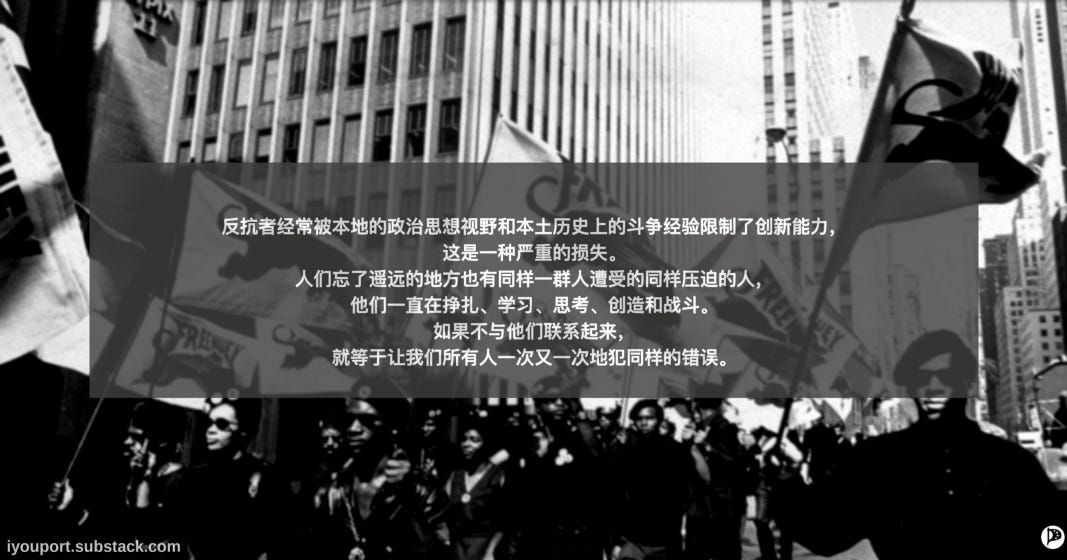
Here's how to artificially speed up evolution:
1. Seeking new combinatorial methods: brainstorming for tactical innovation.
If the action is too complex - think about how to simplify the execution; if the stakes are too high, you can change the goal; if it's not eye-catching enough, make it more spectacular; if it doesn't diffuse well, give it a "point" Dopamine Reinforcement”.
Evolution often occurs blindly, under the influence of random forces. The task of the actor is to consciously accelerate it. Look for small changes or big jumps in the protest strategy recipe that will lead to significant improvements in efficiency.
2. Change an established set of goals (see the CARVER method in Episode 3).
3. Encourage diversity and the emergence of new groups, which will inspire and promote knowledge sharing.
Success or failure depends on the right choices, and every innovative tactic can inspire potential participants (not only offensive tactics, but also other types of activities, such as tactics for creating effective horizontal communities ). The good news is that you don’t have to worry about whether the tactics you choose in the first phase will be effective in the final phase, because by then a new overhaul of the approach will be needed — even if more or less successful means already exist, they will have to continue Be innovative. It is more important to induce a reselection of methods than to imitate a single method.
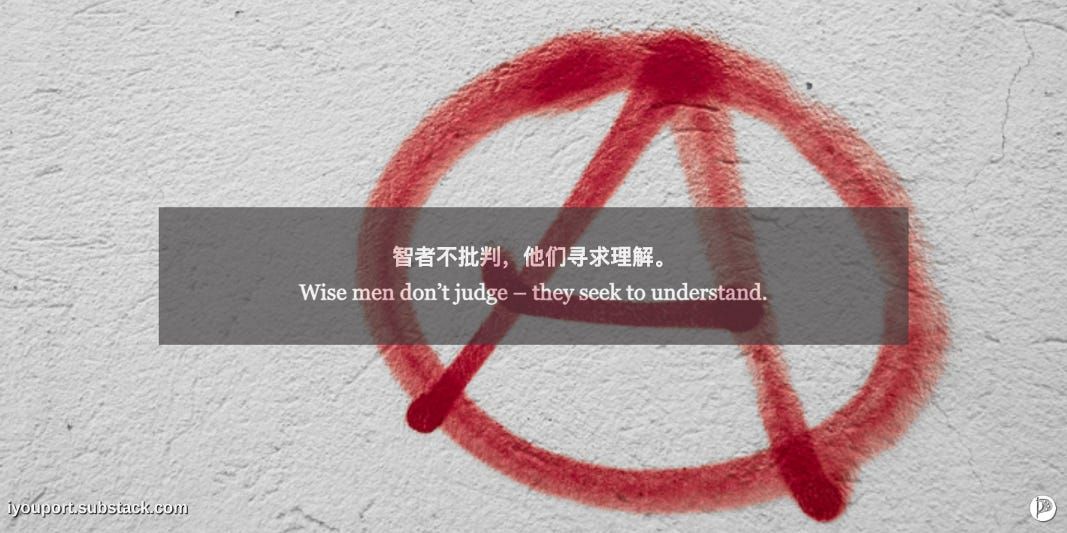
It's important to know that to launch an open source uprising, the founding team must follow simple rules:
1. Let go. The founding team should relinquish any control over the uprising gained in the early stages. In practice, this means giving up any control over achieving goals, who can participate, how communications are organized, etc. The only control left to the founding team is the power of example and respect earned through effective action.
2. Resist the temptation to expand. Keep it small. Do not expand to a size that makes the team an easy target for your adversaries. No formal groups, no hierarchies of control, or complex goals that will cause the open source uprising to splinter/fork.
3. Share. Providing resources, ideas, information, knowledge and manpower to other groups joining the project. Share as much as possible without compromising the focus (safety and viability of the operation).
Exiting is the best option for a successful focus group after achieving an open source uprising. More democratic (and anarchic) forms of post-revolutionary social organization would emerge from the contract of the entire coalition of victorious groups.
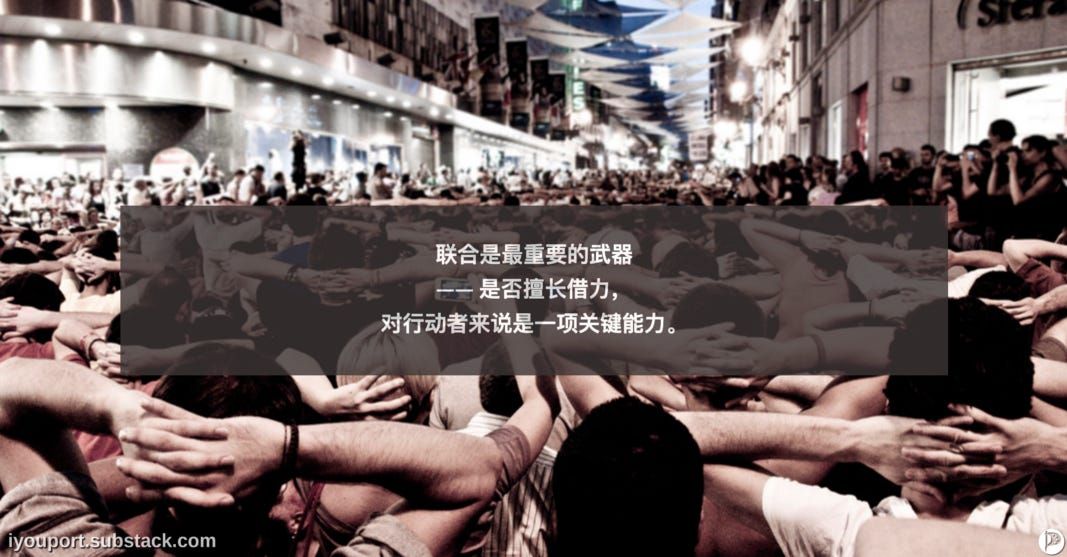
Here are the focus group’s recommended courses of action for launching open source projects:
1. Create a leadership group to launch the project (“focus group”). Recommended for five people. The plan is to disband the focus group once the project is up and running.
2. Raise awareness (basic understanding of key issues in the action strategy).
3. Connect with existing groups (enter open source).
4. Create a campaign to launch the initiative (attract and motivate subsequent participation).
The campaign should be a high-quality attention-grabbing campaign, one that attracts significant attention while clearly demonstrating the possibility of achieving the stated strategic objectives.
The campaign often serves as a vehicle for the first announcement of intent of the action to a broad audience ( if you don't have your own media/spokesperson team or are smaller , the action needs to be large enough that you can parasitize media controlled by others).
5. Form a working group.
6. Enhance the impact of actions through communications technology.
7. Create visible examples of progress. The effectiveness of old instances will continue to decrease, so they need to be continuously updated with new instances (see the description in Episode 2 of this series).
8. Improve skills and learning (share skills/knowledge ).
9. Connect with potential sources of funding and support (group funding is a potential vulnerability and should be treated with caution; but also try to use new and alternative means to redistribute influence)
10. Allow projects to drive themselves.
11. Formalize the plan. Consider not only the contribution of the focus group, but also all contributions that the subgroups will make.
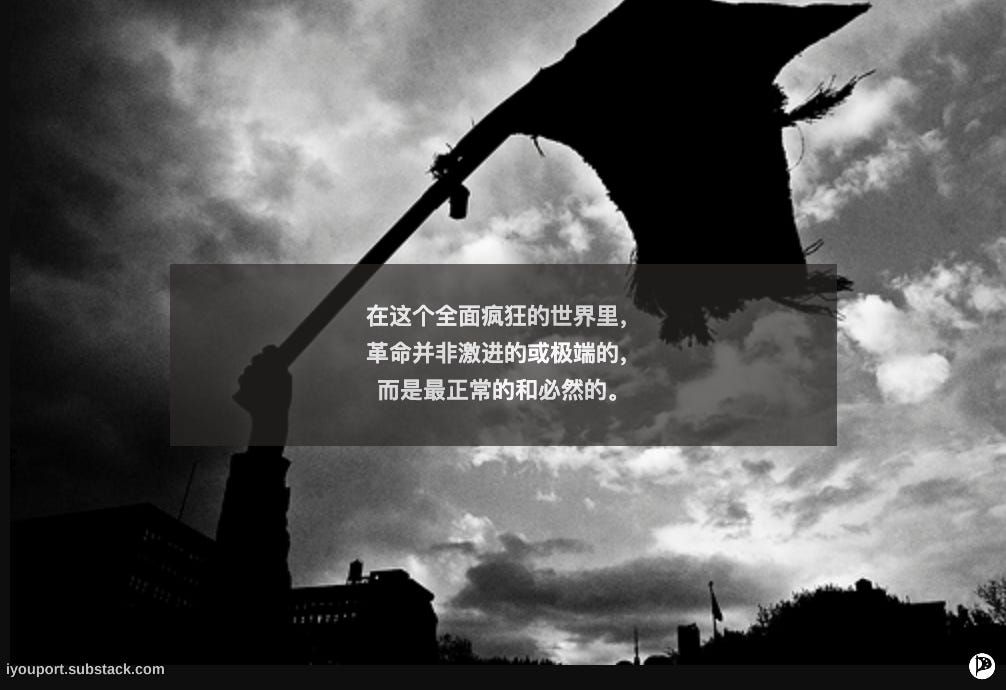
The following are some cases, representatives of successful open source projects that have been launched:
1. Transparency revolution .
This is what we have covered the most, and you can see a summary of the information in Listing-5 .
2. Hacktivism . LulzSec/Anonimous
The LulzSec group is a great example of an open source uprising that acts as a focus group, establishing a credible promise that its hacks are excellent and successful, and proving that despite the expense large organizations spend on security Billions of dollars, but it's still possible to attack and defeat them.
That action sparked imitators/replicators around the world.
Eventually, the group finally called it quits (" 50 days of lulz " on June 26, 2011), relinquishing any formal leadership role. However, less than a month later, the team apparently launched another attack.
If LulzSec can manage to disintegrate and escape being defeated by its opponents, then it will add points to the legitimate promise it has created. However, a series of arrests followed - supposedly arresting all six members of the group. This case should serve as a warning.
LulzSec's style — a combination of serious attacks and non-serious tactics (using memes; addressing targets more like pranks) — makes their operations particularly conspicuous.
Here’s a passage from their website that clearly describes the focal role of the open source uprising :
"For the past 50 days, we have been attacking and denouncing corporations, governments... simply because we can. We hope, desire, even plead, for the movement to spread into a revolution that can continue without us. In such a short time The support we have received has been overwhelming...please don’t stop there. United, we can overthrow our common oppressors and regain the freedom and power we deserve.”
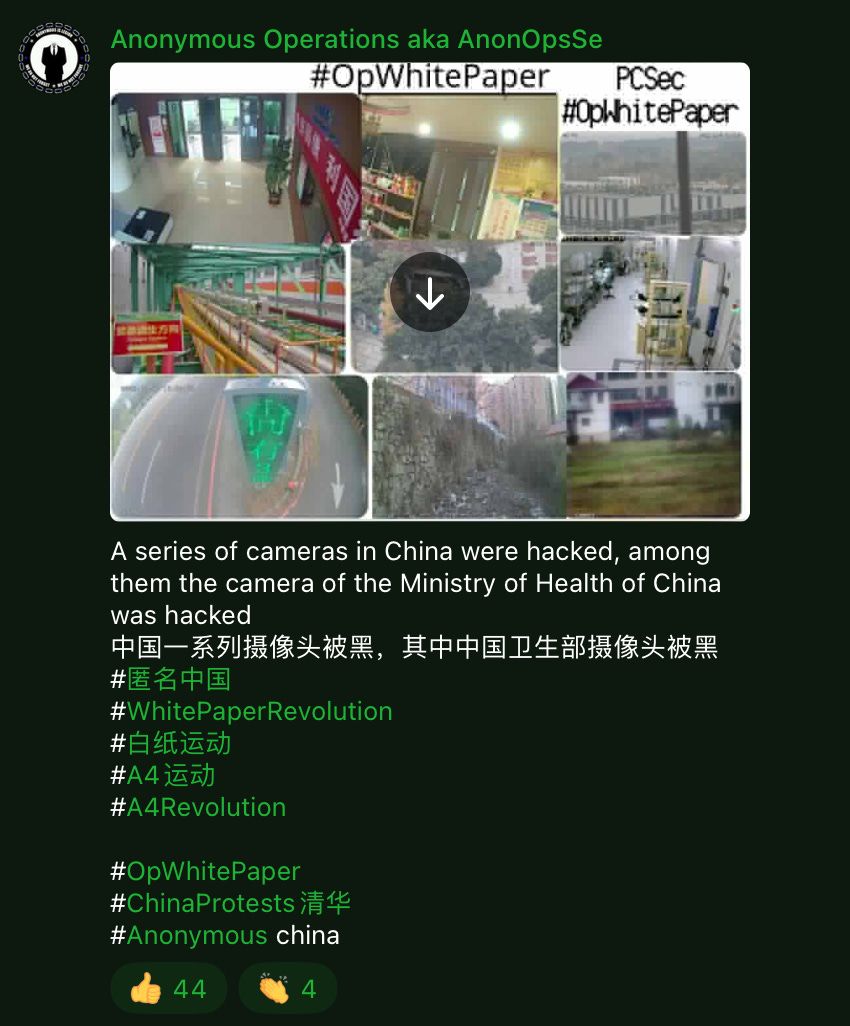
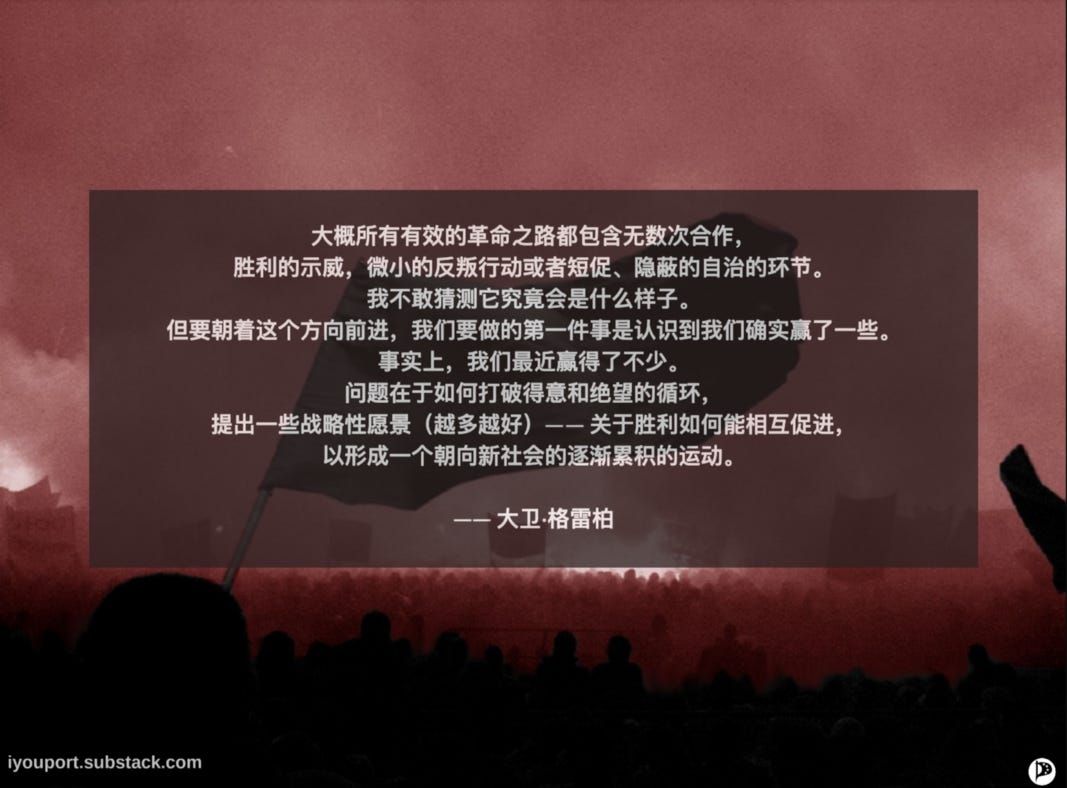
3. Marcos
The Zapatista National Liberation Army did not implement a full-fledged open-source insurrection algorithm, but the story of Subcomandante Marcos is a good example of media "focus" (virtual Ohemeros /collective identity). It tells the story of how contemporary insurrectionists with an anarchist stance have successfully transitioned from traditional violent conflict to using the strength of values and media to achieve their goals without destroying local society.
Subcomandante Marcos became a public figure and the focus of the entire movement's media operations. In this way, the movement is able to gain public support around the world, tie the hands of its opponents, and enter limited areas of conflict where it can call on more peaceful methods to hold its ground. Zapata's experience is an important example of the development of a new anarchist "fighting with love as a weapon" .
In the end, Marcos was able to overcome the temptation of leadership and break down on his own, as all "Focuses" should do. In May 2014, "he" announced that Marcos no longer existed (" Between Light and Shadow " on the official website).
The following passage appears in the postscript to the communiqué issued by Marcos on May 28, 1994 :
Marcos was a gay man in San Francisco, a black man in South Africa, an Asian man in Europe, a Mexican immigrant in San Isidro, an anarchist in Spain, a Palestinian in Israel, an indigenous person on the streets of San Cristobal, Gangsters in the ghetto, rock youth in the university town, Jews in Nazi Germany, integrity investigators in the Mexican Ministry of Defense, feminists in political parties, communists in the post-Cold War era, prisoners in Sitaraba, pacifists in Bosnia , the Mapuche people in the Andes, the teachers in the National Teachers Union, the artist without a gallery or catalog, the housewife on a Saturday night in any part of Mexico, in any city, in any neighborhood, the Mexican guerrillas at the end of the twentieth century, the independence Strikers in trade unions, reporters who are forced to make up gossip, sexists in the feminist movement, single women on the subway at 10pm, retired elderly people sitting in the Plaza de la Constitución in Mexico City, landless farmers, unemployed editors , unemployed workers, doctors without patients, rebellious students, neoliberal dissidents, writers without books or readers, and of course, the Zapatistas of southeastern Mexico. In short, Marcos was like no one else in the world. Marcos was all those marginalized, persecuted, resisting minorities who cried out: “Enough is enough!” (¡Ya basta!). The day all minority groups speak up is the day when the powerful groups fall into silence and endure. All the excluded people are looking for words, their own words, to break up the strong groups. All those who made power and conscience uncomfortable - that was Marcos.
The following text is a speech by an international student at Columbia University during the White Paper protest:
We are the orphans in the square
We are the new shoots after the wildfire
We sank to the bottom of the Yangtze River, we were buried under the train
We had ulterior motives on the bus in Guizhou
We destabilized the fires in Urumqi
We are the low-end population wandering in the prosperous age
We are foreign forces shouting in a dark room
We are Hong Kong people who have lost our home
We are the Uighurs who have lost our freedom
We are Liu Xiaobo and we are Tohti Tohti
We are Liu Xianbin and we are Chen Wei
We are Cao Shunli and we are Li Wangyang
We are Sun Zhigang and we are Lei Yang
We are Yang Jia and we are Wu Gan
We are Guo Yushan and we are Xu Zhiyong
We are Ai Xiaoming and we are Kou Yanding
We are Lu Xianyu and we are Ye Haiyan
We are Gao Zhisheng and we are Yu Wensheng
We are Xia Lin and we are Wang Yu
We are Li Heping and we are Wang Qiaoling
We are Zhang Zhan and we are Huang Simin
We are Li Mingzhe and we are Gui Minhai
We are Gao Yaojie and we are Jiang Yanyong
We are Li Wenliang and we are Peng Zaizhou
We save ourselves in the cabin
We are free in chains
We are the deleted voices
We are expelled consciences
We are the last generation of weaklings
We are a non-essential future
I have to understand and disagree
We stood in front of a tank
We also stood on the Sidao Bridge
We are still standing here today
We will stand in front of you tomorrow
because:
It's my duty!
It's our duty!
Please compare the two paragraphs without interpretation.
4. Russian anti-war movement .
There was an open source uprising within the Russian anti-war movement. As a result of numerous guerrilla attacks, there emerged a rapidly crystallizing commitment that could be expressed as: "The Kremlin is not indestructible, we can attack and hit targets."
In this action project many groups with very different ideologies came together: nationalists, democrats and anarchists worked side by side. Swarms of multi-focal protests emerged in a variety of local settings, involving many long-depoliticized and even regime-loyal people, forming new branches of activity that also included explosive expansion potential.
This is the most beautiful part of guerrilla warfare tactics. The suppressor's firepower is forced to be dispersed and the intensity is severely reduced. Newer protesters continue to replicate and refine specific types of action and organizing.
However, this is not enough. A positive idea of a minimalist image that offers a “beautiful picture of the future” can encapsulate and reinforce many reasons for resistance.
In this case, our task is to shift the specious commitment so that it becomes more expressive of the participant's purpose. And also to expand it to more groups.
There are many other examples of open source uprisings, such as antifa , Occupy , the anti-Trump movement, and more. There is no need to list them all.

Several new practical experiences in recent years have updated the late 20th century approach. include:
1. Ideology vs. action goals.
Traditional open source uprisings like Guevara assume a certain degree of motivational and methodological purity that is maintained in decentralized organizations without the influence of formal hierarchies. But in reality, this may not be the case, because all struggles, like politics, are local; and decentralized struggles are translocal. The open source movement embraces this diversity and sets goals that are often simple, acceptable to most people, and actionable (best described as a reasonable promise, such as "We can topple GFW"). Such a goal without ideological baggage enables a wide range of people with different motivations and backgrounds to join the action project. In addition, all participants can communicate through public means (media/internet). This is not something that any regionalized or ideological system can do.
2. Isolation/independence vs. complex cross-interaction.
According to traditional methods, each participating team can be completely independent of the movement; now, on this basis, open source movements allow all kinds of cross-connections, rapid dissemination of methodological updates, and they even allow the creation of micro-markets. , aggregating the energy of movement through economic interaction.
3. Sponsored rebellion vs. viable rebel economy.
Patrons of uprisings are often motivated by expectations of their own benefit, which is an investment rather than unconditional support. These expectations change as the situation changes, making these investments unstable and influential in the strategy of the uprising. Such is the fragility of traditional uprisings. The open source uprising is not so fragile. It can advance and retreat in various economic activities, and can even innovate micro-economic models. Not only to meet current needs but also to expand the business.

Q: Is this why you always say that “creativity is the most important chip in winning”?
iyp : Yes. It is possible to transcend traditional protests, to transcend traditional uprisings, to avoid the tragic cycle of traditional revolutions .
Q: How can Operation White Paper be understood around the world? Isn’t China special enough? Peng Zaizhou's appeal is for votes, but you always say "direct action". What is the difference here?
iyp : Yes, China has a unique population management system, but the vision of China’s rebels happens to be…
📱 Preview of the next episode’s topics:
What do China’s anti-blockade protests really mean? Where did the people's anger begin? How is direct action more effective than ballots?
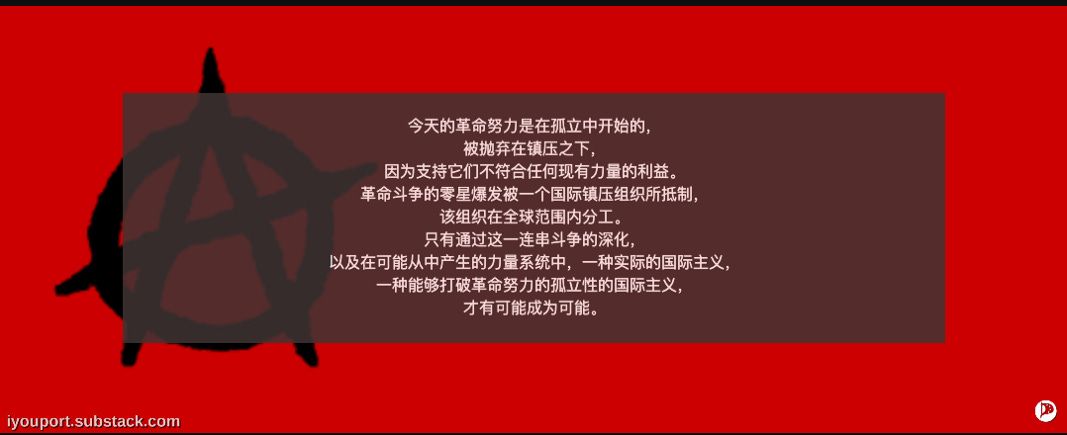
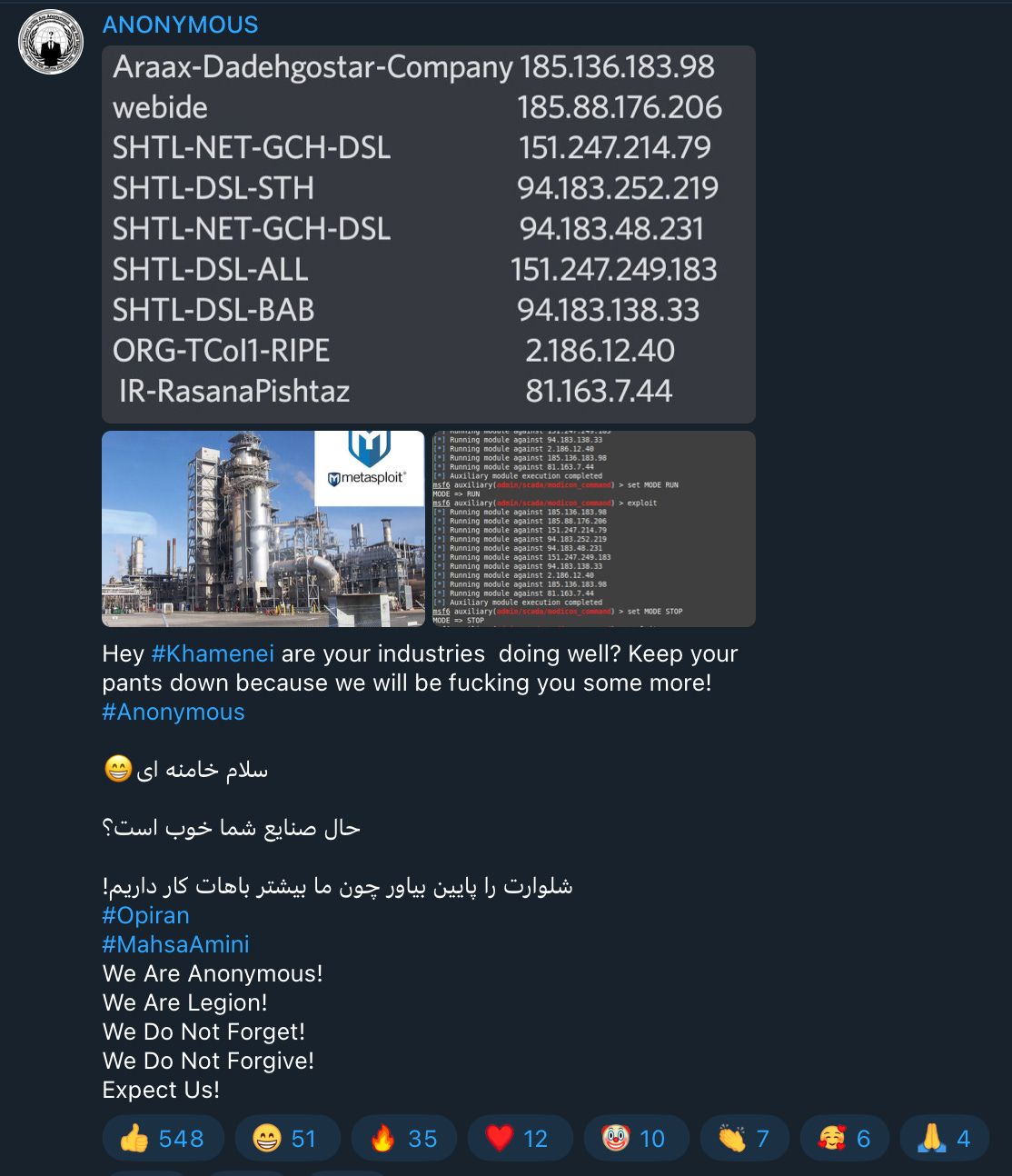
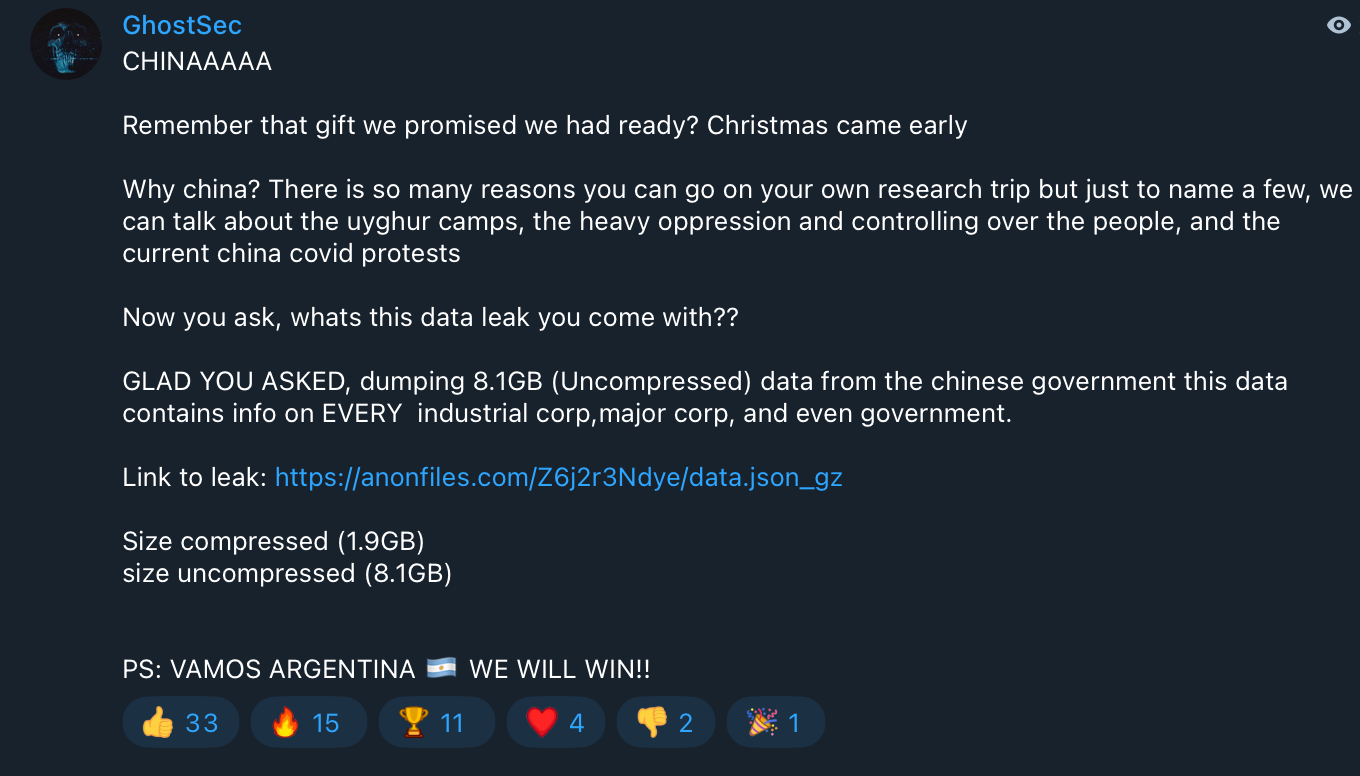
🏴️
——To be continued——
Like my work?
Don't forget to support or like, so I know you are with me..
Comment…